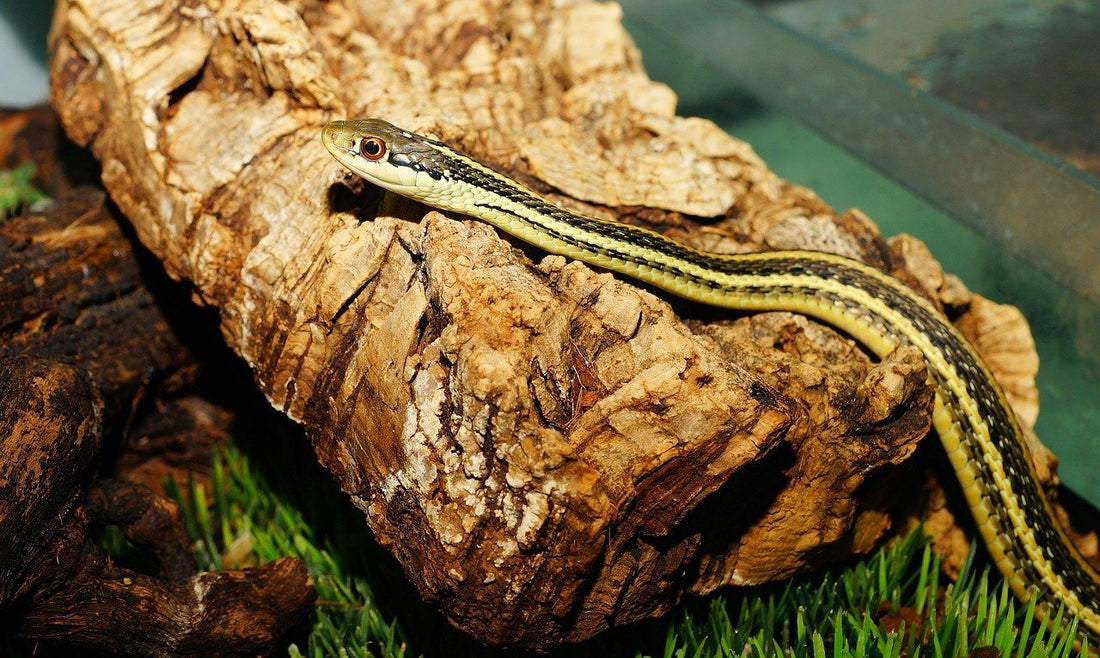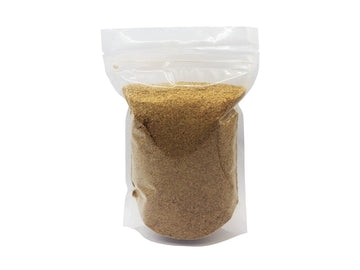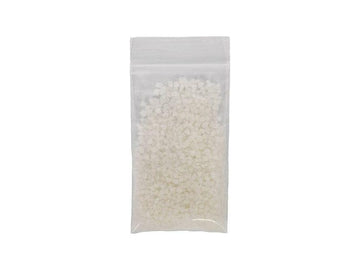The garter snake (Thamnophis sp.) is a 1.5-5’ long, terrestrial, diurnal snake native to North and Central America. They have adapted to a wide variety of habitats, but are generally found near a consistent source of water.
Garter snakes have lightly-built bodies, keeled scales, and big round eyes with round pupils. Unlike many other snakes, they are not constrictors. Color and pattern vary widely based on species.
Garter snakes make hardy, beginner-level pet reptiles when acquired from a breeder rather than captured from the wild. One of the reasons for this is that wild-caught snakes are more stressed around humans and tend to have a high parasite load. When cared for well, a captive-bred garter snake may have a lifespan of up to 12 years.
Care requirements for different species of garter snake will vary slightly, but they’re similar enough that the basics can be covered in a care sheet. We strongly encourage you, however, to do additional research specific to your snake’s particular species.
Minimum terrarium size for garter snakes
Because of the wide variability in garter snake sizes, it’s best to provide a rule of thumb for enclosure sizing rather than give a one-size-fits-all answer to this question. Generally speaking, the minimum acceptable enclosure size for a snake is one where the length and width add up to equal to or greater than the snake’s expected adult length. For example, if you have the type of garter snake that only grows to 18” long, then 12” x 12” x 12” is an acceptable minimum terrarium size. However, if you have the type of garter that grow to 5’ long, then you will need nothing smaller than 36” x 24” x 24”.
Of course, larger is always better! Many people (falsely) believe that garter snakes don’t need very much room because their slender build makes them appear smaller than they actually are. However, the fact is that they’re very active snakes, and need enough room to stretch out fully, explore, and climb as desired.
However, garter snakes are very flexible and can be quite small as youngsters, so make sure that the enclosure is 110% escape-proof. As a general rule, front-opening terrariums with hinged doors tend to be more secure than top-opening tanks or terrariums with sliding doors.
Cohabitation (keeping multiple garter snakes in one enclosure) is optional, and some people argue that garter snakes do better housed with other members of their species. If you wish to give your garter snake a roommate, just make sure that your particular species of garter is not predisposed to cannibalism.
Do garter snakes need UVB?
Technically they can survive without it, but we still recommend providing appropriate UVB lighting for garter snakes. UVB lighting helps provide a clear day/night cycle, provides all of the vitamin D that your pet needs, strengthens the immune system, facilitates better digestion, and other benefits.
The best UVB bulbs for garter snakes are:
- Zoo Med T8 Reptisun 5.0 — 4-6” through mesh
- Arcadia ShadeDweller kit — 6-8” through mesh
- Zoo Med T5 HO Reptisun 5.0 — 9-11” through mesh, 12-14” without
- Arcadia T5 HO Forest 6% — 9-11” through mesh, 12-14” without
Given distances should be between the lamp and the basking surface.
For best results, house the UVB bulbs in a reflective fixture by Arcadia or Vivarium Electronics. Position the lamp on the same side of the terrarium as the heat lamp, and the bulb should be half the length of the enclosure. UVB is blocked by glass and plastic, so placing the terrarium in front of a window doesn’t count as “free UVB” — in fact it can make your terrarium too hot due to the greenhouse effect. Don’t forget to replace your bulb every 12 months!
Lights should be on for about 14 hours/day during summer and 10 hours/day during winter in order to encourage natural hormonal cycling. All lamps should be turned off at night.
Best temperature for garter snakes
Like other reptiles, garter snakes are cold-blooded, which means that they rely on external temperatures to manage their own body temperature and metabolism. A reptile’s enclosure should offer a range of temperatures to allow them to thermoregulate effectively.
Garter snakes should have a basking temperature of 90-95°F. On the other side of the enclosure, the temperature should be around 75-85°F. Heating should be turned off at night so the enclosure can cool down. Make sure to measure the temperatures in your enclosure with at least two digital probe thermometers.
Provide heat for your snake with a halogen flood heat bulb, placed over the basking area (ex: a piece of flagstone or stone paver). For larger snakes, you may need two or more bulbs to evenly heat the snake’s entire body when coiled. Do not use ceramic heat emitters (CHEs), red bulbs, or blue bulbs, as these are not as effective.
Best humidity levels for garter snakes
Garter snakes need an average humidity between 30-60%. There should also be a humid hide for your snake, lined with moistened sphagnum moss. Humidity should be measured via digital probe hygrometer, with the probe placed in the middle of the terrarium.
Increase humidity by misting your snake’s enclosure daily or every other day with a spray bottle. Mixing water directly into the substrate also helps with maintaining high humidity.
Best substrate for garter snakes
Providing a thick layer of naturalistic substrate (“bedding”) will help cushion your garter snake’s body, provides a burrowing medium, maintains correct humidity levels, and also helps make your enclosure more attractive! We recommend the following substrates for garter snakes:
Layering clean, chemical-free leaf litter on top of the substrate can also help with humidity and provides some extra enrichment for your snake.
Substrate should be at least 2” deep and completely replaced every 3-4 months. Remove poop and urates daily, along with contaminated substrate.
How to decorate a garter snake terrarium
An empty terrarium makes for a bored garter snake, reducing its quality of life. Keep your pet entertained and engaged with its environment with the strategic use of décor items that encourage it to exercise natural behaviors!
Here are some ideas for items to add to your garter snake’s new home:
What to feed to a garter snake
Garter snakes are carnivorous, which means that they need to eat whole animal prey in order to get the right nutrition. Feeding frequency varies depending on diet. A garter snake fed primarily on earthworms should be fed twice a week. If it takes mostly fish, then offer food every 5-6 days. Mouse eaters should be fed every 7 days. Juveniles should be fed more often than adults.
Prey items should be around 10% of the snake’s weight and/or no more than 1.5x its width at its widest point. Although live prey can be offered, it’s best to use frozen whenever possible. For safety, use a pair of soft-tipped feeding tweezers to offer prey to your snake, or offer it in a shallow dish or plate.
One of the keys to great nutrition is variety! Here are options for foods you can give offer your pet garter snake:
- dew worms
- chopped nightcrawlers
- leeches
- slugs (captive-bred only)
- sand eels
- whole guppy
- whole molly fish
- whole platy fish
- fish filet (thiaminase-free)
- pinky mice
- quail eggs
- Reptilinks
- garter snake chow
Supplements
For best health, garter snakes should have a calcium and vitamin supplement. We recommend Repashy Calcium Plus LoD, lightly dusted on the prey item before offering.
Water
Of course, don’t forget a large water bowl for your snake to drink from and soak in! Change the water daily and scrub the bowl with a reptile-safe disinfectant weekly, or whenever it becomes soiled.
How to handle your garter snake
Reptiles generally don’t appreciate petting and handling in the same way that dogs and cats do. Some garter snakes don’t mind handling, while others are best left alone. Get to know your individual snake and act accordingly.
When picking up your snake, be gentle and try to pick it up from the side or below rather than from above. Support as much of its body as possible, and NEVER pick it up by its tail, as this can damage its spine!
*This care sheet contains only very basic information. Although it’s a good introduction, please further your research with high-quality sources. The more you know, the better you will be able to care for your pet!
Image by Karsten Paulick from Pixabay











